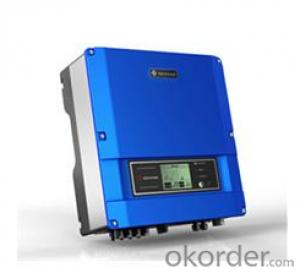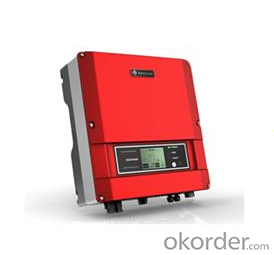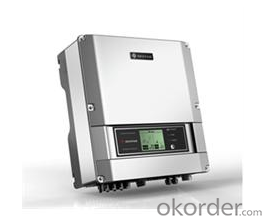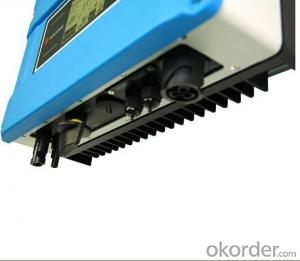Sharp Solar Inverter GS4200-DS On Grid Solar Inverter
- Loading Port:
- Shanghai
- Payment Terms:
- TT OR LC
- Min Order Qty:
- 10 unit
- Supply Capability:
- 100 unit/month
OKorder Service Pledge
OKorder Financial Service
You Might Also Like
GW4200-DS
GW4200-DS photovoltaic inverter is suitable for home rooftop photovoltaic system, designed under modern industrial concept. There are three colors for option with fashionable appearance. This model uses advanced digital control technology and communication method as well as super MPP tracking and security technology. It has a wide range of input and output voltage. To ensure its stability and long service life, our inverter is manufactured with optimum quality components. It holds a safe lead among the same level of products.
| DC Input Data | Max.PV-generator power[W] | 4600 |
| Max.DC power each MPPT[W] | 2500 | |
| Max.DC voltage[V] | 580 | |
| MPPT voltage range[V] | 125~550 | |
| Turn on DC voltage[V] | 125 | |
Max.DC work current[A] | 2*15 | |
| Number of inputs/MPP trackers | 4/2(can parrallel) | |
| DC connector | MC IV connector | |
| Self-energy consumption[W] | <5< td=""> | |
| AC Output Data | Nominal AC power[W] | 4200 |
| Max.AC power[W] | 4400 | |
| Max.output current[A] | 21 | |
| Nominal output voltage range | According to VDE-AR-N 4105, RD1663, ENEL, G59,SAA | |
| AC grid frequency | According to VDE-AR-N 4105, RD1663, ENEL, G59,SAA | |
| THDi | 〈2% | |
| Power factor | 0.95 leading...0.95 lagging | |
| AC connection | Single phase | |
| Efficiency | Max.efficiency | 97.8% |
| European efficiency | 97.4% | |
| MPPT adaptation efficiency | >99.5% | |
| Safty Equipment | Leakage current monitoring unit | Integrated |
| DC switch disconnector | Optional | |
| Islanding protection | AFD | |
| Grid monitoring | According to VDE-AR-N 4105,AS4777.1/2/3, RD1663, ENEL,G59-2 | |
| Normative Reference | EMC compliance | EN 61000-6-1,EN 61000-6-2, EN 61000-6-3,EN 61000-6-4 |
| Safety compliance | According to IEC 62109-1,AS3100 | |
| General Data | Dimensions(W*H*D) [mm] | 390*417*165 |
| Net weight [kg] | 20 | |
| Housing | For outdoor and indoor | |
| Mounting information | Wall mounting | |
| Operating temperature range | -20~60℃(up 45℃ derating) | |
| Relative humidity | 0 ~ 95% | |
| Site altitude[m] | 2000 | |
| IP proection class | IP65 | |
| Topology | Transformerless | |
| Cooling | Nature Convection | |
| Noise level[dB] | 〈25 | |
| Display | 4" LCD | |
| Communication | USB2.0;RS485(Wireless/Bluetooth optional) | |
| Standard warranty[years] | 5/10(optional) |
- Q: How do you choose the right voltage rating for a solar inverter?
- When choosing the right voltage rating for a solar inverter, it is important to consider a few factors. Firstly, you should check the voltage rating of your solar panels to ensure compatibility with the inverter. Secondly, consider your system's voltage requirements, including the voltage of your battery bank or grid connection. Lastly, take into account the distance between your inverter and the solar panels, as voltage drop can occur over long distances. By considering these factors, you can select a solar inverter with the appropriate voltage rating for optimal performance and efficiency.
- Q: Is the grid side of the grid and the inverter?
- Grid-type system power transmission sequence: photovoltaic panels> relays> inverters> relays> electricity load + power grid (both in parallel).
- Q: What are the installation requirements for a solar inverter?
- The installation requirements for a solar inverter typically include a suitable mounting location, adequate ventilation, and a compatible electrical system. It should be installed in an area with good sunlight exposure and away from any shading or obstructions. The inverter should be mounted securely on a sturdy surface, preferably indoors or in a weatherproof enclosure. Proper grounding and electrical connections are also necessary to ensure safe and efficient operation. It is essential to follow the manufacturer's guidelines and local electrical codes during installation.
- Q: How does a solar inverter handle voltage sags or swells in the grid?
- A solar inverter handles voltage sags or swells in the grid by constantly monitoring the grid voltage. When it detects a voltage sag (drop below a certain threshold) or swell (increase above a certain threshold), it adjusts its output accordingly. In the case of a sag, the inverter boosts its output voltage to compensate for the drop in grid voltage. Conversely, in the case of a swell, the inverter reduces its output voltage to prevent any damage to connected devices. This ensures that the solar inverter maintains a stable and consistent voltage supply to the connected load, regardless of fluctuations in the grid voltage.
- Q: Can a solar inverter be used with a solar-powered remote monitoring system?
- Yes, a solar inverter can be used with a solar-powered remote monitoring system. The solar inverter converts the DC (direct current) electricity generated by the solar panels into AC (alternating current) electricity that can be used to power the remote monitoring system. This allows the system to be powered by solar energy and provides the necessary electricity for monitoring and data transmission.
- Q: Can a solar inverter be used with different types of monitoring systems?
- Yes, a solar inverter can be used with different types of monitoring systems. Solar inverters are designed to convert the direct current (DC) electricity produced by solar panels into alternating current (AC) electricity that can be used in homes or businesses. While some inverters come with built-in monitoring systems, they can also be connected to external monitoring systems that provide more advanced data and analytics. This allows users to monitor and manage their solar power generation and consumption effectively, regardless of the monitoring system they choose to use.
- Q: What is the role of a solar inverter in a community solar project?
- The role of a solar inverter in a community solar project is to convert the direct current (DC) electricity generated by the solar panels into alternating current (AC) electricity that can be used to power homes and businesses. It also ensures that the electricity is synchronized with the utility grid and optimizes the efficiency of the solar power system.
- Q: Can a solar inverter be used in mobile applications?
- Yes, a solar inverter can be used in mobile applications. Portable solar inverters are designed specifically for mobile use and are commonly used in recreational vehicles, boats, camping, and other off-grid applications. These inverters convert the direct current (DC) generated by solar panels into alternating current (AC) to power mobile devices and appliances.
- Q: How does a solar inverter interact with a battery storage system?
- A solar inverter interacts with a battery storage system by converting the direct current (DC) generated by the solar panels into alternating current (AC) that can be used to power household appliances or be fed back into the grid. It also manages the charging and discharging of the battery, ensuring efficient energy storage and utilization.
- Q: How does MPPT improve the efficiency of a solar inverter?
- MPPT, or Maximum Power Point Tracking, improves the efficiency of a solar inverter by constantly adjusting the operating point of the solar panel to extract maximum power from the sunlight. It ensures that the solar panel operates at its maximum power point, regardless of changing weather conditions or variations in the solar irradiance. This optimization leads to higher energy conversion efficiency, maximizing the power output of the solar panel and ultimately increasing the overall efficiency of the solar inverter.
Send your message to us
Sharp Solar Inverter GS4200-DS On Grid Solar Inverter
- Loading Port:
- Shanghai
- Payment Terms:
- TT OR LC
- Min Order Qty:
- 10 unit
- Supply Capability:
- 100 unit/month
OKorder Service Pledge
OKorder Financial Service
Similar products
Hot products
Hot Searches
Related keywords




























